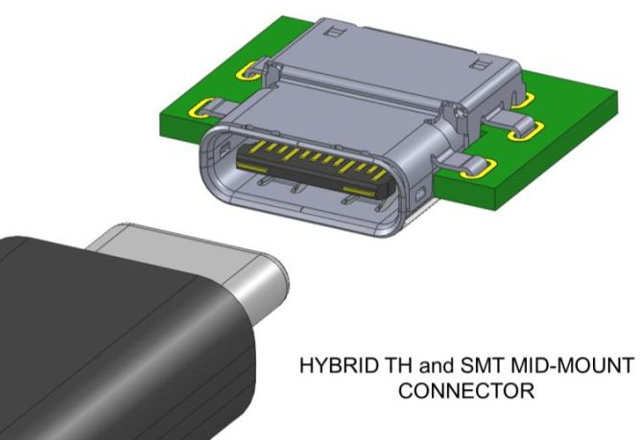We now have all sorts of USB receptacles and connectors, but this is supposed to eventually change thanks to type-C connectors, which are small and robust enough to be used in laptop, computer, smartphones, and other type of devices, and will replace the USB type A, micro and mini USB ports. Type-C connectors will also be reversible, so there won’t be a way to insert the cable upside down. The USB 3.0 Promoter Group has just announced the completion of the USB Type-C specification, and transferred it to the USB Implementers Forum (USB-IF) for ongoing management and the establishment of a compliance and certification program.
Key features of Type C specifications include:
- Entirely new design
- Tailored for emerging product designs
- Robust enough for laptops and tablets; slim enough for mobile phones
- Similar to size of USB 2.0 Micro-B
- Usability enhancements – Reversible plug orientation and cable direction
- Supports scalable power charging
- Future scalability – Designed to support future USB performance needs
- Mechanical specs
- Receptacle opening: ~8.4mm x ~2.6mm
- Durability: 10,000 cycles
- Improved EMI- and RFI-mitigation features
- Power delivery capacity – 3A for standard cables and 5A for connectors
USB Type-C is not compatible with older USB connectors and receptacles, so for backward compatibility, the USB-IF has defined cables which will allow older devices to connect to the new connector, and newer devices to connect to the older connectors. Type C cables and connectors support USB performance at SuperSpeed USB 10 Gbps (USB 3.1) and USB Power Delivery up to 100W.
“USB Type-C Cable and Connector Specification Revision 1.0” is available as part of USB 3.1 specifications. Since the standard has just been finalized, it will take some time to see devices and cables compliant with Type-C specs.
Via Anandtech and Liliputing

Jean-Luc started CNX Software in 2010 as a part-time endeavor, before quitting his job as a software engineering manager, and starting to write daily news, and reviews full time later in 2011.
Support CNX Software! Donate via cryptocurrencies, become a Patron on Patreon, or purchase goods on Amazon or Aliexpress






USB Power Delivery up to 100W is impressive.
We’ll see if Apple will continue to oppose 😛
But… looking at connectors/cables specifications 5V@3A means 15W, 5V@5A means 25W so how 100 watt fits here? Probabli 100W will be the host aggegated max power capability??
@giovanni.v
The 100W comes from the fact that the USB “Power Delivery” specifications include the option of using 20V voltage level… Good decision, or not, but that is the marketing ploy, so in theory the connector is capable to deliver 60W (3A * 20V), is that actually achievable for longer than few seconds worth, do not know (yet), but would not count on stable 60W on such thin wires.
ref: http://www.usb.org/developers/powerdelivery/
If you would’ve looked into the USB-C specs you would have noticed that judging by count of contributors Apple is 3rd (only Intel and JAE sent more engineers to the workgroup). When you look through USB power delivery specs also released in 2014 you would notice that no company sent more engineers to this workgroup than Apple. For a simple reason: To prevent these USB sh*t shows we’re plagued with today (Micro USB, USB3-A, proprietary charging crap) happening again.